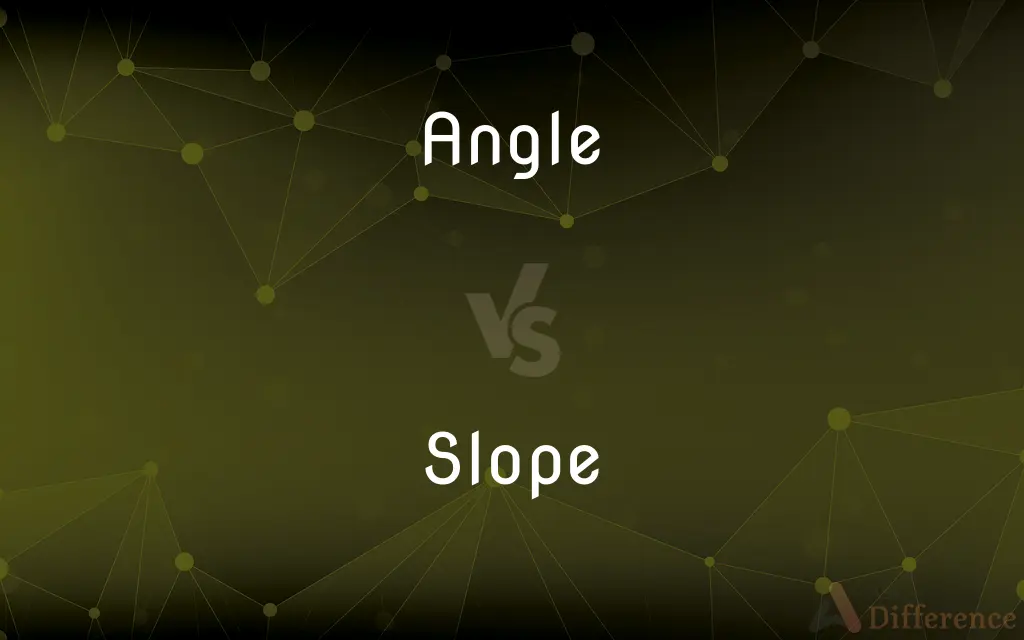Angle vs. Slope — What's the Difference?
By Tayyaba Rehman & Fiza Rafique — Updated on April 5, 2024
Angle is a measure of rotation between two intersecting lines, while slope indicates how steep a line is on a graph.

Difference Between Angle and Slope
Table of Contents
ADVERTISEMENT
Key Differences
Angle refers to the space between two intersecting lines or surfaces at or close to the point where they meet. It is measured in degrees or radians, indicating the degree of rotation needed to superimpose one of the lines on the other. Slope, on the other hand, is a mathematical concept used primarily in algebra and geometry to describe the steepness, incline, or decline of a line in a coordinate plane. It is calculated as the ratio of the vertical change to the horizontal change between two points on the line.
While angles are used in various fields such as geometry, physics, and engineering to describe the orientation or rotation between objects, slopes are crucial in calculus, construction, and road design, helping to understand the change in elevation. Angles can be complementary or supplementary, depending on their sum being 90 degrees or 180 degrees, respectively, whereas slopes can be positive, negative, zero, or undefined, reflecting the direction and steepness of a line.
Angles are often represented using symbols such as θ or α, and they form the basis of trigonometry, which studies relationships between side lengths and angles of triangles. Slopes, however, are represented by the letter 'm' in the equation of a line (y = mx + b), where 'm' is the slope and 'b' is the y-intercept. This representation is key in solving various algebraic problems involving linear equations.
Understanding angles is essential for the study of polygons, circular motion, and many physical laws, such as those involving torque and equilibrium. Slopes are indispensable in understanding and interpreting graphs of linear functions, designing ramps and inclines, and analyzing economic models, where they can represent rates of change, such as cost per unit.
In practical applications, angles help in setting the correct orientation for objects, such as in satellite dish installation, while slopes determine how gradients are managed in road construction, ensuring safety and efficiency. Both concepts are vital in their respective domains, yet they serve different purposes and follow distinct mathematical principles.
ADVERTISEMENT
Comparison Chart
Definition
Measure of rotation between two lines
Steepness of a line
Units
Degrees (°), Radians (rad)
Ratio of vertical change to horizontal change
Fields of Use
Geometry, Physics, Engineering
Algebra, Geometry, Calculus
Representation
θ, α
M (in y = mx + b)
Practical Example
Satellite dish orientation
Road construction gradient
Compare with Definitions
Angle
A measure of the rotation needed to superimpose one of two intersecting lines onto the other.
The angle between two streets at an intersection was exactly 90 degrees, forming a perfect right angle.
Slope
Determines the gradient for roads and ramps.
The slope of the ramp was calculated to accommodate both pedestrians and wheelchairs.
Angle
Describes orientation and rotational forces.
The torque on a bolt is proportional to the force applied and the angle at which it is applied.
Slope
The ratio of vertical change to horizontal change between two points on a line.
The slope of the roof was designed to ensure proper water drainage.
Angle
Used to describe the shape and structure of polygons.
A triangle's internal angles always sum up to 180 degrees.
Slope
Represents the steepness and direction of a line.
The line's equation y = 2x + 3 indicates a slope of 2, meaning it rises two units for every one unit it runs horizontally.
Angle
Helps in locating celestial objects.
The angle of elevation to the star was 45 degrees above the horizon.
Slope
Represents rates of change, such as cost per unit.
The supply curve's slope showed how the quantity supplied changes with price.
Angle
Applied in setting up objects correctly.
The carpenter set the angle of the saw to 45 degrees to make the cut.
Slope
Used to find the derivative of a function.
The slope of the tangent line to the curve at any point gives the rate of change at that point.
Angle
In Euclidean geometry, an angle is the figure formed by two rays, called the sides of the angle, sharing a common endpoint, called the vertex of the angle. Angles formed by two rays lie in the plane that contains the rays.
Slope
In mathematics, the slope or gradient of a line is a number that describes both the direction and the steepness of the line. Slope is often denoted by the letter m; there is no clear answer to the question why the letter m is used for slope, but its earliest use in English appears in O'Brien (1844) who wrote the equation of a straight line as "y = mx + b" and it can also be found in Todhunter (1888) who wrote it as "y = mx + c".Slope is calculated by finding the ratio of the "vertical change" to the "horizontal change" between (any) two distinct points on a line.
Angle
To fish with a hook and line.
Slope
A surface of which one end or side is at a higher level than another; a rising or falling surface
He slithered helplessly down the slope
Angle
To try to get something by indirect or artful means
Angle for a promotion.
Slope
A person from East Asia, especially Vietnam.
Angle
To move or turn (something) at an angle
Angled the chair toward the window.
Slope
(of a surface or line) be inclined from a horizontal or vertical line; slant up or down
The garden sloped down to a stream
The ceiling sloped
Angle
(Sports)To hit (a ball or puck, for example) at an angle.
Slope
Move in an idle or aimless manner
I had seen Don sloping about the beach
Angle
(Informal)To impart a biased aspect or point of view to
Angled the story in a way that criticized the candidate.
Slope
To diverge from the vertical or horizontal; incline
A roof that slopes.
Angle
To continue along or turn at an angle or by angles
The road angles sharply to the left. The path angled through the woods.
Slope
To move or walk
"Without another word he turned and sloped off down the driveway" (Roald Dahl).
Angle
A fishhook or fishing tackle.
Slope
To cause to slope
Sloped the path down the bank.
Angle
The figure formed by two lines diverging from a common point.
Slope
An inclined line, surface, plane, position, or direction.
Angle
The figure formed by two planes diverging from a common line.
Slope
A stretch of ground forming a natural or artificial incline
Ski slopes.
Angle
The rotation required to superimpose either of two such lines or planes on the other.
Slope
A deviation from the horizontal.
Angle
The space between such lines or surfaces.
Slope
The amount or degree of such deviation.
Angle
A solid angle.
Slope
The rate at which an ordinate of a point of a line on a coordinate plane changes with respect to a change in the abscissa.
Angle
A sharp or projecting corner, as of a building.
Slope
The tangent of the angle of inclination of a line, or the slope of the tangent line for a curve or surface.
Angle
The place, position, or direction from which an object is presented to view
A building that looks impressive from any angle.
Slope
Offensive Slang Used as a disparaging term for a person of East Asian birth or ancestry.
Angle
An aspect, as of a problem, seen from a specific point of view.
Slope
An area of ground that tends evenly upward or downward.
I had to climb a small slope to get to the site.
A steep slope
Angle
(Slang)A devious method; a scheme.
Slope
The degree to which a surface tends upward or downward.
The road has a very sharp downward slope at that point.
Angle
A member of a Germanic people that migrated to England from southern Jutland in the 5th century AD, founded the kingdoms of Northumbria, East Anglia, and Mercia, and together with the Jutes and Saxons formed the Anglo-Saxon peoples.
Slope
(mathematics) The ratio of the vertical and horizontal distances between two points on a line; zero if the line is horizontal, undefined if it is vertical.
The slope of this line is 0.5
Angle
(geometry) A figure formed by two rays which start from a common point (a plane angle) or by three planes that intersect (a solid angle). Category:en:Shapes
The angle between lines A and B
Slope
(mathematics) The slope of the line tangent to a curve at a given point.
The slope of a parabola increases linearly with x.
Angle
(geometry) The measure of such a figure. In the case of a plane angle, this is the ratio (or proportional to the ratio) of the arc length to the radius of a section of a circle cut by the two rays, centered at their common point. In the case of a solid angle, this is the ratio of the surface area to the square of the radius of the section of a sphere.
The angle between lines A and B is π/4 radians, or 45 degrees.
Slope
The angle a roof surface makes with the horizontal, expressed as a ratio of the units of vertical rise to the units of horizontal length (sometimes referred to as run).
The slope of an asphalt shingle roof system should be 4:12 or greater.
Angle
A corner where two walls intersect.
An angle of a building
Slope
A person of Chinese or other East Asian descent.
Angle
A change in direction.
The horse took off at an angle.
Slope
(intransitive) To tend steadily upward or downward.
The road slopes sharply down at that point.
Angle
A viewpoint; a way of looking at something.
Slope
(transitive) To form with a slope; to give an oblique or slanting direction to; to incline or slant.
To slope the ground in a garden;
To slope a piece of cloth in cutting a garment
Angle
(media) The focus of a news story.
Slope
To try to move surreptitiously.
I sloped in through the back door, hoping my boss wouldn't see me.
Angle
Any of various hesperiid butterflies.
Slope
(military) To hold a rifle at a slope with forearm perpendicular to the body in front holding the butt, the rifle resting on the shoulder.
The order was given to "slope arms".
Angle
A storyline between two wrestlers, providing the background for and approach to a feud.
Slope
(obsolete) Sloping.
Angle
(slang) An ulterior motive; a scheme or means of benefitting from a situation, usually hidden, often immoral
His angle is that he gets a percentage, but mostly in trade.
Slope
(obsolete) slopingly
Angle
A projecting or sharp corner; an angular fragment.
Slope
An oblique direction; a line or direction including from a horizontal line or direction; also, sometimes, an inclination, as of one line or surface to another.
Angle
(astrology) Any of the four cardinal points of an astrological chart: the Ascendant, the Midheaven, the Descendant and the Imum Coeli.
Slope
Any ground whose surface forms an angle with the plane of the horizon.
Buildings the summit and slope of a hill.
Under the slopes of Pisgah.
Angle
A fishhook; tackle for catching fish, consisting of a line, hook, and bait, with or without a rod.
Slope
The part of a continent descending toward, and draining to, a particular ocean; as, the Pacific slope.
Angle
To place (something) at an angle.
The roof is angled at 15 degrees.
Slope
Sloping.
A bank not steep, but gently slope.
Angle
To change direction rapidly.
The five ball angled off the nine ball but failed to reach the pocket.
Slope
In a sloping manner.
Angle
To present or argue something in a particular way or from a particular viewpoint.
How do you want to angle this when we talk to the client?
Slope
To form with a slope; to give an oblique or slanting direction to; to direct obliquely; to incline; to slant; as, to slope the ground in a garden; to slope a piece of cloth in cutting a garment.
Angle
To hamper (oneself or one's opponent) by leaving the cue ball in the jaws of a pocket such that the surround of the pocket (the "angle") blocks the path from cue ball to object ball.
Slope
To take an oblique direction; to be at an angle with the plane of the horizon; to incline; as, the ground slopes.
Angle
To try to catch fish with a hook and line.
Slope
To depart; to disappear suddenly.
Angle
To attempt to subtly persuade someone to offer a desired thing.
He must be angling for a pay rise.
Slope
An elevated geological formation;
He climbed the steep slope
The house was built on the side of the mountain
Angle
The inclosed space near the point where two lines meet; a corner; a nook.
Into the utmost angle of the world.
To search the tenderest angles of the heart.
Slope
The property possessed by a line or surface that departs from the horizontal;
A five-degree gradient
Angle
The figure made by. two lines which meet.
Slope
Be at an angle;
The terrain sloped down
Angle
A projecting or sharp corner; an angular fragment.
Though but an angle reached him of the stone.
Angle
A name given to four of the twelve astrological "houses."
Angle
A fishhook; tackle for catching fish, consisting of a line, hook, and bait, with or without a rod.
Give me mine angle: we 'll to the river there.
A fisher next his trembling angle bears.
Angle
To fish with an angle (fishhook), or with hook and line.
Angle
To use some bait or artifice; to intrigue; to scheme; as, to angle for praise.
The hearts of all that he did angle for.
Angle
To try to gain by some insinuating artifice; to allure.
Angle
The space between two lines or planes that intersect; the inclination of one line to another; measured in degrees or radians
Angle
A biased way of looking at or presenting something
Angle
A member of a Germanic people who conquered England and merged with the Saxons and Jutes to become Anglo-Saxons
Angle
Move or proceed at an angle;
He angled his way into the room
Angle
To incline or bend from a vertical position;
She leaned over the banister
Angle
Seek indirectly;
Fish for compliments
Angle
Fish with a hook
Angle
Present with a bias;
He biased his presentation so as to please the share holders
Common Curiosities
What is an angle?
An angle is a measure of the space between two intersecting lines or surfaces, measured in degrees or radians.
Can angles be negative?
Angles themselves are not negative; they range from 0° to 360° in standard position, but angular displacement can be considered negative in rotational motion, indicating direction.
How are angles used in daily life?
Angles are used in various ways, including determining the correct orientation for installing objects like satellite dishes and in designing structures.
What is a complementary angle?
Complementary angles are two angles whose sum equals 90 degrees.
How is slope used in construction?
Slope is used to determine the gradient for roads, ramps, and roofs to ensure safety, efficiency, and proper drainage.
What does slope represent?
Slope represents the steepness, incline, or decline of a line on a graph, calculated as the ratio of vertical change to horizontal change between two points.
Can a slope be zero?
Yes, a slope can be zero. This indicates a horizontal line where there is no vertical change as one moves along the line.
How do slopes affect road design?
Slopes are critical in road design for ensuring proper drainage, safety in inclines and declines, and overall road usability.
How are angles and slopes measured?
Angles are measured in degrees or radians using tools like protractors, while slopes are calculated as a ratio of vertical to horizontal change.
What is the difference between an acute angle and a positive slope?
An acute angle is any angle less than 90 degrees, indicating a sharp intersection. A positive slope means a line rises as it moves from left to right, indicating upward inclination.
Can both concepts be applied in the same field?
Yes, both angles and slopes are crucial in fields like construction and design, where orientation and gradient are key considerations.
What does an undefined slope indicate?
An undefined slope indicates a vertical line where the horizontal change is zero, making the slope calculation impossible due to division by zero.
How do angles relate to trigonometry?
Angles are fundamental to trigonometry, which studies the relationships between the angles and side lengths of triangles.
What is a negative slope?
A negative slope indicates that a line decreases as it moves from left to right, representing a downward inclination.
Is it possible for an angle to be 180 degrees?
Yes, a 180-degree angle is a straight line, representing a straight angle.
Share Your Discovery

Previous Comparison
Vodafone vs. Orange
Next Comparison
Concentration vs. MolarityAuthor Spotlight
Written by
Tayyaba RehmanTayyaba Rehman is a distinguished writer, currently serving as a primary contributor to askdifference.com. As a researcher in semantics and etymology, Tayyaba's passion for the complexity of languages and their distinctions has found a perfect home on the platform. Tayyaba delves into the intricacies of language, distinguishing between commonly confused words and phrases, thereby providing clarity for readers worldwide.
Co-written by
Fiza RafiqueFiza Rafique is a skilled content writer at AskDifference.com, where she meticulously refines and enhances written pieces. Drawing from her vast editorial expertise, Fiza ensures clarity, accuracy, and precision in every article. Passionate about language, she continually seeks to elevate the quality of content for readers worldwide.














































